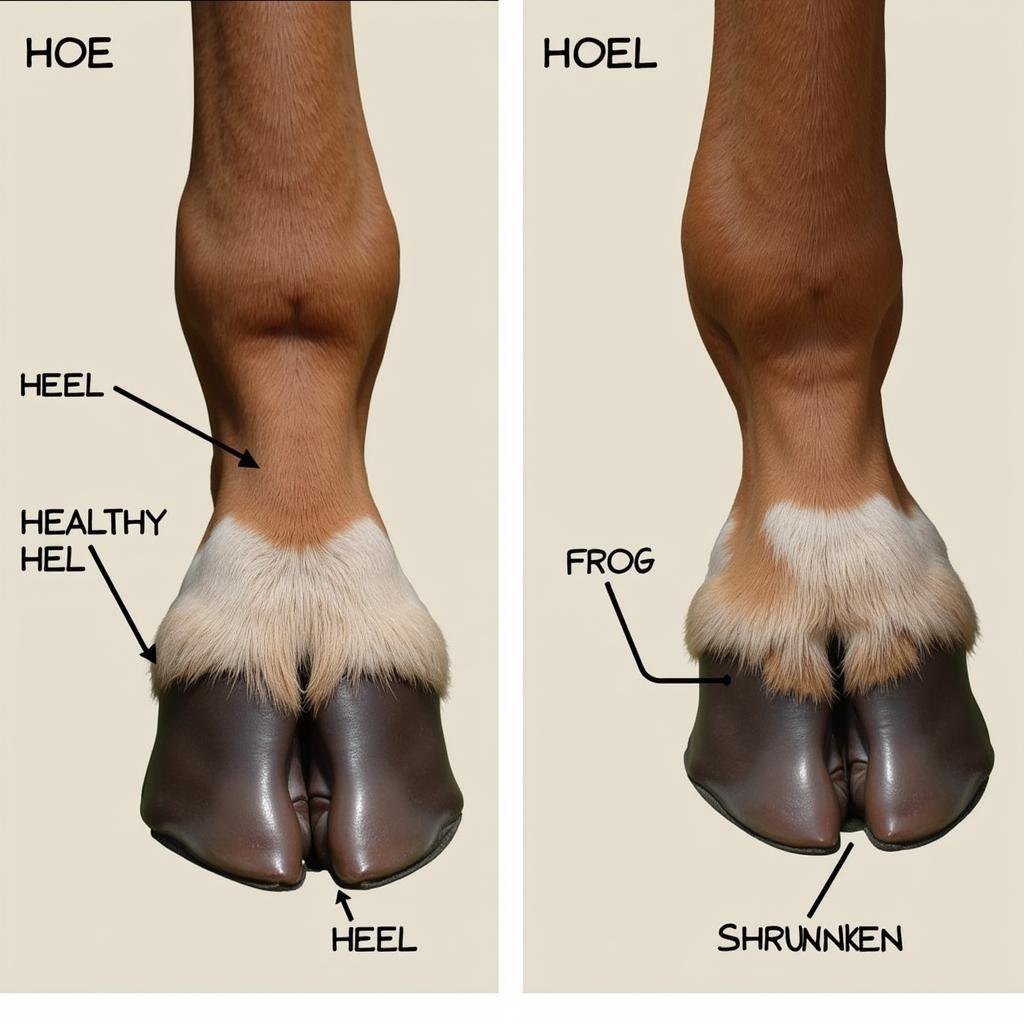Contracted heels in horses are a common hoof problem that can cause lameness and discomfort. This condition, characterized by a narrow heel and a shrunken frog, can be caused by various factors, ranging from improper trimming and shoeing to genetics and environmental influences. Understanding the causes, symptoms, and treatment options for contracted heels is crucial for maintaining your horse’s hoof health and overall well-being.
What are Contracted Heels in Horses?
Contracted heels are a narrowing of the horse’s heels, causing the frog to shrink and lose its healthy, flexible nature. This restriction can significantly impact the horse’s movement and comfort. Recognizing the signs early and addressing the issue promptly can prevent further complications and ensure your horse’s long-term soundness. The heels should have some flexibility, allowing them to expand and contract with each stride. Contracted heels limit this natural movement, impacting shock absorption and potentially leading to other hoof problems.
 Example of Contracted Heels in a Horse
Example of Contracted Heels in a Horse
Causes of Contracted Heels
Several factors can contribute to contracted heels, including:
- Improper trimming and shoeing: One of the most common causes is consistently trimming the heels too low or using shoes that don’t support the natural expansion of the heel. Check out our article on horse heels for more information.
- Genetics: Some horses are genetically predisposed to developing contracted heels.
- Environment: Dry, hard ground can contribute to the problem, as it doesn’t allow the frog to receive adequate moisture and stimulation. Consider using the best hoof moisturizer for horses to maintain optimal hoof hydration.
- Lack of movement: Horses confined to stalls for long periods may not get the necessary movement to stimulate healthy hoof growth.
- Imbalance in hoof trimming: Uneven trimming can cause one heel to contract more than the other.
Identifying Contracted Heels: Key Signs
Recognizing the signs of contracted heels is vital for early intervention. Here are some key indicators to look for:
- Narrow heels: The heels appear closer together than normal.
- Shrunken frog: The frog appears smaller and harder than usual.
- Deep central sulcus: The groove in the middle of the frog becomes deep and narrow.
- Rings and ridges on the hoof wall: The hoof wall may display abnormal rings and ridges, indicating uneven growth.
- Lameness or stiffness: The horse may exhibit signs of lameness, particularly on hard surfaces.
 Identifying Contracted Heels in Horses
Identifying Contracted Heels in Horses
“Early detection is key,” says Dr. Emily Carter, DVM, an equine veterinarian with over 20 years of experience. “The sooner you address contracted heels, the better the chances of a full recovery and prevention of long-term issues.”
Treatment and Management of Contracted Heels
Treating contracted heels involves addressing the underlying cause and promoting healthy hoof growth. Options include:
- Corrective trimming and shoeing: A farrier can trim the hooves to encourage heel expansion and apply therapeutic shoes, such as bar shoes horse, to provide support.
- Regular exercise: Turnout and regular exercise on varied terrain stimulate blood flow and encourage hoof expansion.
- Hoof moisturizers and dressings: Keeping the hooves moist and pliable can help prevent further contraction and promote frog health. For severe cases, your vet might recommend products like thrush buster horse to address any underlying infections.
- Dietary supplements: Certain supplements, such as biotin, can support healthy hoof growth.
“Addressing any underlying hoof infections, like thrush, is essential for successful treatment,” advises Sarah Miller, a certified farrier with 15 years of experience. “A healthy frog is crucial for proper hoof function.”
Conclusion
Contracted heels are a serious hoof problem that requires prompt attention. By understanding the causes, recognizing the symptoms, and implementing appropriate treatment strategies, you can help your horse regain healthy, functional hooves and maintain long-term soundness. Remember, regular farrier visits and a proactive approach to hoof care are crucial for preventing and managing contracted heels. For more information on hoof-related issues, check out our article on the root and bone horse shoe.
FAQ
- What are the long-term effects of untreated contracted heels?
- Can contracted heels be prevented?
- How often should a horse with contracted heels be seen by a farrier?
- Are certain breeds more prone to contracted heels?
- What is the role of nutrition in hoof health?
- How long does it take to correct contracted heels?
- Can a horse with contracted heels be ridden?
When you need assistance, please contact Phone Number: 0772127271, Email: [email protected] Or visit: QGM2+WX2, Vị Trung, Vị Thuỷ, Hậu Giang, Việt Nam. We have a 24/7 customer service team.